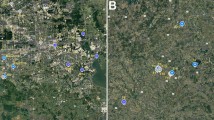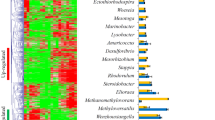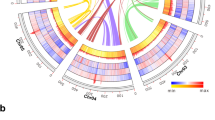Abstract
Several types of environmental bacteria that can aerobically degrade various aromatic compounds have been identified. The catabolic genes in these bacteria have generally been found to form operons, which promote efficient and complete degradation. However, little is known about the degradation pathways in bacteria that are difficult to culture in the laboratory. By functionally screening a metagenomic library created from activated sludge, we had earlier identified 91 fosmid clones carrying genes for extradiol dioxygenase (EDO), a key enzyme in the degradation of aromatic compounds. In this study, we analyzed 38 of these fosmids for the presence and organization of novel genes for aromatics degradation. Only two of the metagenomic clones contained complete degradation pathways similar to those found in known aromatic compound-utilizing bacteria. The rest of the clones contained only subsets of the pathway genes, with novel gene arrangements. A circular 36.7-kb DNA form was assembled from the sequences of clones carrying genes belonging to a novel EDO subfamily. This plasmid-like DNA form, designated pSKYE1, possessed genes for DNA replication and stable maintenance as well as a small set of genes for phenol degradation; the encoded enzymes, phenol hydroxylase and EDO, are capable of the detoxification of aromatic compounds. This gene set was found in 20 of the 38 analyzed clones, suggesting that this ‘detoxification apparatus’ may be widespread in the environment.
Similar content being viewed by others
Log in or create a free account to read this content
Gain free access to this article, as well as selected content from this journal and more on nature.com
or
Accession codes
References
Abe T, Kanaya S, Kinouchi M, Ichiba Y, Kozuki T, Ikemura T . (2003). Informatics for unveiling hidden genome signatures. Genome Res 13: 693–702.
Altschul SF, Madden TL, Schaffer AA, Zhang J, Zhang Z, Miller W et al. (1997). Gapped BLAST and PSI-BLAST: A new generation of protein database search programs. Nucleic Acids Res 25: 3389–3402.
Amann RI, Ludwig W, Schleifer KH . (1995). Phylogenetic identification and in situ detection of individual microbial cells without cultivation. Microbiol Rev 59: 143–169.
Arai H, Ohishi T, Chang MY, Kudo T . (2000). Arrangement and regulation of the genes for meta-pathway enzymes required for degradation of phenol in Comamonas testosteroni TA441. Microbiology 146: 1707–1715.
Bartosik D, Putyrski M, Dziewit L, Malewska E, Szymanik M, Jagiello E et al. (2008). Transposable modules generated by a single copy of insertion sequence ISPme1 and their influence on structure and evolution of natural plasmids of Paracoccus methylutens DM12. J Bacteriol 190: 3306–3313.
Basta T, Buerger S, Stolz A . (2005). Structural and replicative diversity of large plasmids from sphingomonads that degrade polycyclic aromatic compounds and xenobiotics. Microbiology 151: 2025–2037.
Benndorf D, Loffhagen N, Babel W . (2001). Protein synthesis patterns in Acinetobacter calcoaceticus induced by phenol and catechol show specificities of responses to chemostress. FEMS Microbiol Lett 200: 247–252.
Cevallos MA, Cervantes-Rivera R, Gutiérrez-Ríos RM . (2008). The repABC plasmid family. Plasmid 60: 19–37.
Dennis JJ . (2005). The evolution of IncP catabolic plasmids. Curr Opin Biotechnol 16: 291–298.
Duffner FM, Kirchner U, Bauer MP, Müller R . (2000). Phenol/cresol degradation by the thermophilic Bacillus thermoglucosidasius A7: Cloning and sequence analysis of five genes involved in the pathway. Gene 256: 215–221.
Dziewit L, Jazurek M, Drewniak L, Baj J, Bartosik D . (2007). The SXT conjugative element and linear prophage N15 encode toxin-antitoxin-stabilizing systems homologous to the tad-ata module of the Paracoccus aminophilus plasmid pAMI2. J Bacteriol 189: 1983–1997.
Eltis LD, Bolin JT . (1996). Evolutionary relationships among extradiol dioxygenases. J Bacteriol 178: 5930–5937.
Esteve-Núñez A, Caballero A, Ramos JL . (2001). Biological degradation of 2,4,6-trinitrotoluene. Microbiol Mol Biol Rev 65: 335–352.
Finn RD, Tate J, Mistry J, Coggill PC, Sammut SJ, Hotz HR et al. (2008). The Pfam protein families database. Nucleic Acids Res 36: D281–D288.
Fukumori F, Saint CP . (2001). Complete nucleotide sequence of the catechol metabolic region of plasmid pTDN1. J Gen Appl Microbiol 47: 329–333.
Furukawa K, Suenaga H, Goto M . (2004). Biphenyl dioxygenase: functional versatilities and directed evolution. J Bacteriol 186: 5189–5196.
Galvao TC, Mohn WW, de Lorenzo V . (2005). Exploring the microbial biodegradation and biotransformation gene pool. Trends Biotechnol 23: 497–506.
Gibson DT, Parales RE . (2000). Aromatic hydrocarbon dioxygenases in environmental biotechnology. Curr Opin Biotechnol 11: 236–243.
Gibson J, Harwood CS . (2002). Metabolic diversity in aromatic compound utilization by anaerobic microbes. Annu Rev Microbiol 56: 345–369.
Junca H, Pieper DH . (2004). Functional gene diversity analysis in BTEX contaminated soils by means of PCR-SSCP DNA fingerprinting: Comparative diversity assessment against bacterial isolates and PCR-DNA clone libraries. Environ Microbiol 6: 95–110.
Kholodii GY, Mindlin SZ, Bass IA, Yurieva OV, Minakhina SV, Nikiforov VG . (1995). Four genes, two ends, and a res region are involved in transposition of Tn5053: a paradigm for a novel family of transposons carrying either a mer operon or an integron. Mol Microbiol 17: 1189–1200.
Kim IC, Oriel PJ . (1995). Characterization of the Bacillus stearothermophilus BR219 phenol hydroxylase gene. Appl Environ Microbiol 61: 1252–1256.
Lowe TM, Eddy SR . (1997). tRNAscan-SE: a program for improved detection of transfer RNA genes in genomic sequence. Nucleic Acids Res 25: 955–964.
Minakhina S, Kholodii G, Mindlin S, Yurieva O, Nikiforov V . (1999). Tn5053 family transposons are res site hunters sensing plasmidal res sites occupied by cognate resolvases. Mol Microbiol 33: 1059–1068.
Mohn WW, Garmendia J, Galvao TC, de Lorenzo V . (2006). Surveying biotransformations with à la carte genetic traps: translating dehydrochlorination of lindane (gamma-hexachlorocyclohexane) into lacZ-based phenotypes. Environ Micobiol 8: 546–555.
Nojiri H, Shintani M, Omori T . (2004). Divergence of mobile genetic elements involved in the distribution of xenobiotic-catabolic capacity. Appl Microbiol Biotechnol 64: 154–174.
Ohtsubo Y, Ikeda-Ohtsubo W, Nagata Y, Tsuda M . (2008). GenomeMatcher: a graphical user interface for DNA sequence comparison. BMC Bioinformatics 9: 376.
Oppon JC, Sarnovsky RJ, Craig NL, Rawlings DE . (1998). A Tn7-like transposon is present in the glmUS region of the obligately chemoautolithotrophic bacterium Thiobacillus ferrooxidans. J Bacteriol 180: 3007–3012.
Quevillon E, Silventoinen V, Pillai S, Harte N, Mulder N, Apweiler R et al. (2005). InterProScan: protein domains identifier. Nucleic Acids Res 33: W116–W120.
Rutherford K, Parkhill J, Crook J, Horsnell T, Rice P, Rajandream MA et al. (2000). Artemis: sequence visualization and annotation. Bioinformatics 16: 944–945.
Sambrook J, Russell DW . (2001). Molecular Cloning: A Laboratory Manual. Cold Spring Harbor Press, Cold Spring Harbor: New York, USA.
Schröder G, Lanka E . (2005). The mating pair formation system of conjugative plasmids—A versatile secretion machinery for transfer of proteins and DNA. Plasmid 54: 1–25.
Shingler V, Powlowski J, Marklund U . (1992). Nucleotide sequence and functional analysis of the complete phenol/3,4-dimethyl phenol catabolic pathway of Pseudomonas sp. strain CF600. J Bacteriol 174: 711–724.
Sipilä TP, Keskinen A-K, Åkerman M-L, Fortelius C, Haahtela K, Yrjälä K . (2008). High aromatic ring-cleavage diversity in birch rhizosphere: PAH treatment-specific changes of I.E.3 group extradiol dioxygenases and 16S rRNA bacterial communities in soil. ISME J 2: 968–981.
Sota M, Yano H, Ono A, Miyazaki R, Ishii H, Genka H et al. (2006a). Genomic and functional analysis of the IncP-9 naphthalene-catabolic plasmid NAH7 and its transposon Tn4655 suggests catabolic gene spread by a tyrosine recombinase. J Bacteriol 188: 4057–4067.
Sota M, Yano H, Nagata Y, Ohtsubo Y, Genka H, Anbutsu H et al. (2006b). Functional analysis of unique class II insertion sequence IS1071. Appl Environ Microbiol 72: 291–297.
Stamoudis VC, Luthy RG . (1980). Determination of biological removal of organic constituents in quench waters from high-BTU coal-gasification pilot plants. Water Res 14: 1143–1156.
Suenaga H, Ohnuki T, Miyazaki K . (2007). Functional screening of a metagenomic library for genes involved in microbial degradation of aromatic compounds. Environ Microbiol 9: 2289–2297.
Tennstedt T, Szczepanowski R, Krahn I, Pühler A, Schlüter A . (2005). Sequence of the 68 869 bp IncP-1α plasmid pTB11 from a waste-water treatment plant reveals a highly conserved backbone, a Tn402-like integron and other transposable elements. Plasmid 53: 218–238.
Top EM, Springael D . (2003). The role of mobile genetic elements in bacterial adaptation to xenobiotic organic compounds. Curr Opin Biotechnol 14: 262–269.
Toussaint A, Merlin C, Monchy S, Benotmane MA, Leplae R, Mergeay M et al. (2003). The biphenyl- and 4-chlorobiphenyl-catabolic transposon Tn4371, a member of a new family of genomic islands related to IncP and Ti plasmids. Appl Environ Microbiol 69: 4837–4845.
Tsuda M, Tan HM, Nishi A, Furukawa K . (1999). Mobile catabolic genes in bacteria. J Biosci Bioeng 87: 401–410.
van der Geize R, Dijkhuizen L . (2004). Harnessing the catabolic diversity of rhodococci for environmental and biotechnological applications. Curr Opin Microbiol 7: 255–261.
van der Meer JR, de Vos WM, Harayama S, Zehnder AJ . (1992). Molecular mechanisms of genetic adaptation to xenobiotic compounds. Microbiol Rev 56: 677–694.
Watanabe T, Inoue R, Kimura N, Furukawa K . (2000). Versatile transcription of biphenyl catabolic bph operon in Pseudomonas pseudoalcaligenes KF707. J Biol Chem 275: 31016–31023.
Wittich R-M . (1998). Degradation of dioxin-like compounds by microorganisms. Appl Microbiol Biotechnol 49: 489–499.
Williams PA, Sayers JR . (1994). The evolution of pathways for aromatic hydrocarbon oxidation in Pseudomonas. Biodegradation 5: 195–217.
Zhou N-Y, Fuenmayor SL, Williams PA . (2001). nag genes of Ralstonia (formerly Pseudomonas) sp. strain U2 encoding enzymes for gentisate catabolism. J Bacteriol 183: 700–708.
Acknowledgements
This work was supported by Grants-in-Aid from the Ministry of Education, Culture, Sports, Science and Technology, Japan. RM and MM were supported by Research Fellowships of the Japan Society for the Promotion of Science for Young Scientists.
Author information
Authors and Affiliations
Corresponding authors
Additional information
Supplementary Information accompanies the paper on The ISME Journal website (http://www.nature.com/ismej)
Supplementary information
Rights and permissions
About this article
Cite this article
Suenaga, H., Koyama, Y., Miyakoshi, M. et al. Novel organization of aromatic degradation pathway genes in a microbial community as revealed by metagenomic analysis. ISME J 3, 1335–1348 (2009). https://doi.org/10.1038/ismej.2009.76
Received:
Revised:
Accepted:
Published:
Issue date:
DOI: https://doi.org/10.1038/ismej.2009.76
Keywords
This article is cited by
-
Metagenomic analysis reveals specific BTEX degrading microorganisms of a bacterial consortium
AMB Express (2023)
-
Whole genome strategies and bioremediation insight into dehalogenase-producing bacteria
Molecular Biology Reports (2021)
-
Research progress in bioremediation of petroleum pollution
Environmental Science and Pollution Research (2021)
-
Comparative mangrove metagenome reveals global prevalence of heavy metals and antibiotic resistome across different ecosystems
Scientific Reports (2018)
-
Evolutionary, computational, and biochemical studies of the salicylaldehyde dehydrogenases in the naphthalene degradation pathway
Scientific Reports (2017)



